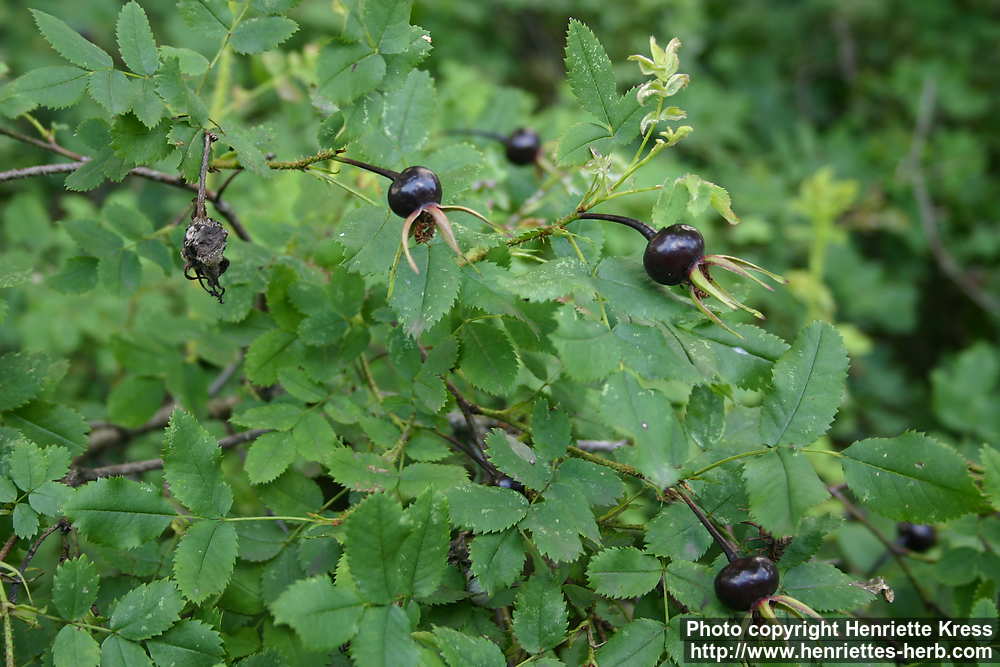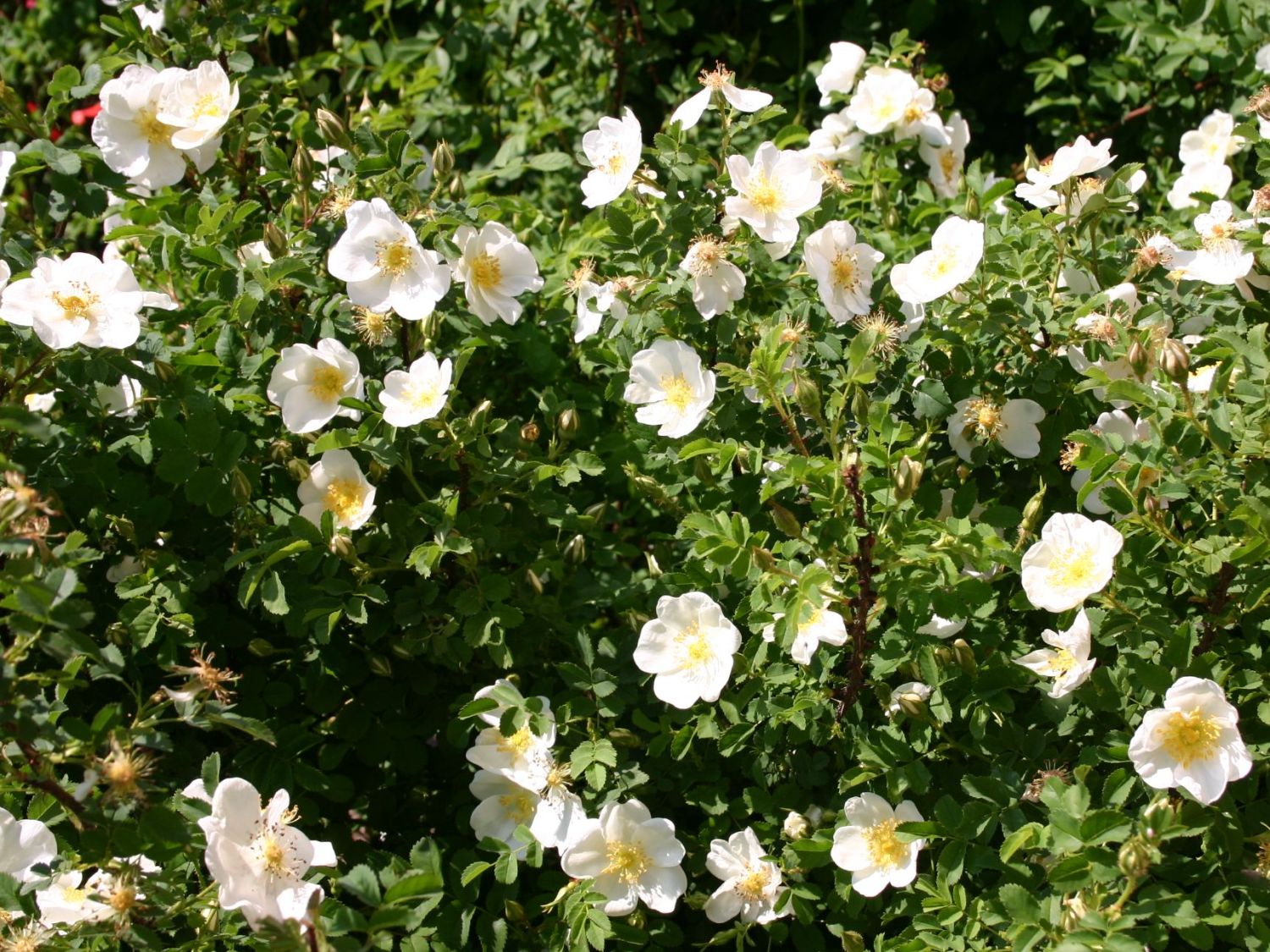Rosa pimpinellifolia
Rosa spinosissima
The Burnet Rose (Rosa spinosissima ) was described in 1753 by Carolus Linnaeus first time under the currently valid scientific names. It is often found under the name Rosa L. pimpinellifolia in the literature. Rosa spinosissima has a number of other German names such as dune - Rose, Prickly Rose and Rock Rose. It is one of the oldest roses that are cultivated in Europe and Asia. The cultivated varieties have a pronounced wild character.
Description
Appearance
The burnet rose grows as a shrub that reaches heights of growth from 30 to 180 centimeters. It forms from underground runners which ensure the vegetative propagation. The burnet rose has dark brown, erect to ascending, highly branched branches. The brownish branches are densely covered with straight and slightly uneven, rarely curved five to eight millimeters long spines and rough, pointed bristles. The flowering shoots have fewer and shorter spines than the main shoots.
The dull to dark green and hairless leaves are ( five to ) pinnate seven to elfteilig. The leaflets have a nearly circular to elliptical shape. The leaf margin serrate double glandular. The venation is barely visible. The stipules have pointed ears and rarely they form a glandular Perforation of.
Flower and Fruit
The flowers are single, but relatively dense and numerous on the short side shoots on a loose glands stieldrüsigen up scattered from 1.5 to 2.5 cm long peduncle. The radial symmetry, slightly fragrant flowers of decay have a diameter of 4 inches and a pure white to reddish tarnished color. The sepals are entire, about an inch long and repulsed and spread after pollination. The pen is available in a very wide channel pen and is covered by a broad, woolly head scars. The flowering period extends from May to June. The fruit stalk is usually longer than the globose compressed or bottle-shaped black to purple- black rose hip.
Ecology
At their sites, the burnet rose often occurs in colonies. Colony formation is due to the many meters of root suckers. As Wurzelkriech pioneer the plant bears with their branched floor foothills to the ground hold at. The very deep root system is an important adaptation to the location of dune represents the very small leaves and the unusually dense spines and bristles are interpreted as weak xerophytic features. With its flowers, which homo game " pollen - disk flowers " are, it is as bee pasture of ecological importance. Furthermore, the rosehip birds and small mammals serve as food.
Dissemination
The burnet rose occurs mainly on the North Sea coast and the North Sea islands. Your preferred location there are the ridges of gray dunes. They can also be found inland on silicate Magerrasen Central and southern Germany, the Pyrenees and Southern Alps at altitudes of 2000 m, where, however, relatively rare. Also in the northern Balkan countries colonized the plant suitable locations. In its eastern distribution area you meet the burnet mainly in dry hedges and bushes, Berberitzengebüschen, Schlehengesellschaften and dry forests.
Locations and adaptation
Natural stocks of the burnet rose bushes are sunny and forest edges, lime - poor grassland (especially on the coasts in dune sands ). On dry, calcareous, shallow soil, stony - sandy loam She is a light plant, indicating nitrogen- poor locations. On rocks it has location due to extreme dwarfism, with lack of light it is slow-growing and blütenlos. Phytosociological it is a Ordnungskennart the dune willow thickets ( Salicetum arenariae ). The dunes rose bushes ( Roso pimpinellifolii - Salicetum arenariae ) usually populated south-facing slopes of the gray dunes. In the herb layer species of beach grass meadows dominate. In particular acidophytische species, such as dog - violets, Real Speedwell or Field Wood-rush are typical companion.
The Dune Rose is also planted as an ornamental plant in gardens and parks.
Protection
The Dünenrose is often pushed to their ancestral locations of faster growing wild rose species. On some islands, such as Amrum there is therefore initiatives that pull up bushes the ecological niches of Dünenrose regularly.
Use
The burnet rose is cultivated with us since the 16th century as an ornamental plant. It is a form- rich species which has been hybridized with other species and used for crosses with garden roses. So many varieties are created with white, pink and yellow, but also with double flowers. In the landscape of care it is used for embankment attachment ( var altaica) and reclamation.
The rose hips are rich in vitamins and well suited for the extraction of rose hip tea, jam, marmalade, jelly, juice, syrup and pastry fillings. The production of wine, brandy and liqueur is possible.
The Dünenrose in the culture
Vonne van der Meer, a contemporary Dutch writer, sat with her novel Island guests who puts the House " Dune Rose " with its various guests to the center of the plot, the plant is a monument.
Varieties
- Rosa spinosissima var altaica ( Willdenow ) Rehder
- Rosa spinosissima var spinosissima
- R. spinosissima var altaica ( Willd.) Rehd.
- R. Spinosissima var andrewsii Willm.
- R. spinosissima var australis ( Rouy )
Varieties (Selection)
- 'Double Yellow', with golden yellow petals.
- 'Single Red', with red petals.
- 'Red Nelly ', with red petals.
- ' Stanwell Perpetual ', breeding 1838, with zartrosanen petals, blooms often.
Gallery
Rosa spinosissima

.jpg)








